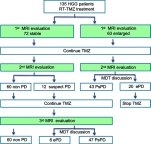Neutrophil-lymphocyte ratio dynamics are useful for distinguishing between recurrence and pseudoprogression in high-grade gliomas
- PMID: 31303796
- PMCID: PMC6611708
- DOI: 10.2147/CMAR.S202546
Neutrophil-lymphocyte ratio dynamics are useful for distinguishing between recurrence and pseudoprogression in high-grade gliomas
Abstract
Objective: Distinguishing recurrence and pseudoprogression is a major challenge in the clinical practice of treatment for high-grade gliomas (HGGs). The neutrophil-lymphocyte ratio (NLR) has been reported to be closely related to survival in HGGs. We aimed to assess the predictive value of NLR in the differential diagnosis of recurrence and pseudoprogression.
Materials and methods: A total of 135 patients with histologically confirmed HGGs were studied. All patients underwent focal radiotherapy and concomitant temozolomide (TMZ), followed by 6 cycles of TMZ if MRI showed no progressive enlargement of contrast-enhancing lesions. MRI evaluation was taken 4 weeks after concurrent chemoradiotherapy and then every 2 months later. NLR was calculated at 4 time points of preoperation, before concurrent RT-TMZ (pretreatment), 4 weeks following completion of RT-TMZ, and MRI showed lesion enlarged or treatment completed.
Results: In 135 patients, 47 (34.8%) were found to be pseudoprogression (PsPD), and 28 (20.7%) were early disease progression (ePD). The mean pretreatment and post-treatment NLR were 4.2±2.1 and 5.1±3.5, respectively. The median overall survival in the PsPD group (25.2 months) was significantly longer than in the ePD (15.4 months) and no progression group (nPD) (21.6 months) (p<0.001). Overall survival was significantly shorter in the baseline NLR≥4 cohort compared with NLR<4 (p=0.03), but no significant difference was found between PsPD and ePD (p=0.197). Patients with decreased NLR showed significantly longer survival than no decreased group (p<0.001), and decreased NLR was found to be a significant difference between PsPD and ePD (p=0.022). Univariate and multivariate logistic regression analyses suggested that decreased NLR was an independent prognosis factor (p=0.031).
Conclusion: Decreased NLR is an independent prognostic factor and is useful for distinguishing between recurrence and pseudoprogression in HGGs.
Keywords: high-grade gliomas; neutrophil–lymphocyte ratio; prognostic factors; pseudoprogression.
Conflict of interest statement
The authors report no conflicts of interest in this work.
Figures





Similar articles
-
Pseudoprogression in patients with malignant gliomas treated with concurrent temozolomide and radiotherapy: potential role of p53.J Neurooncol. 2011 Mar;102(1):157-62. doi: 10.1007/s11060-010-0305-7. Epub 2010 Jul 15. J Neurooncol. 2011. PMID: 20632071
-
IDH mutation and MGMT promoter methylation are associated with the pseudoprogression and improved prognosis of glioblastoma multiforme patients who have undergone concurrent and adjuvant temozolomide-based chemoradiotherapy.Clin Neurol Neurosurg. 2016 Dec;151:31-36. doi: 10.1016/j.clineuro.2016.10.004. Epub 2016 Oct 12. Clin Neurol Neurosurg. 2016. PMID: 27764705
-
Neutrophil-lymphocyte ratio dynamics during concurrent chemo-radiotherapy for glioblastoma is an independent predictor for overall survival.J Neurooncol. 2017 May;132(3):463-471. doi: 10.1007/s11060-017-2395-y. Epub 2017 Mar 22. J Neurooncol. 2017. PMID: 28332000
-
Pseudoprogression following chemoradiotherapy for glioblastoma multiforme.Can J Neurol Sci. 2010 Jan;37(1):36-42. doi: 10.1017/s0317167100009628. Can J Neurol Sci. 2010. PMID: 20169771
-
Early post-treatment pseudo-progression amongst glioblastoma multiforme patients treated with radiotherapy and temozolomide: a retrospective analysis.J Med Imaging Radiat Oncol. 2011 Dec;55(6):603-10. doi: 10.1111/j.1754-9485.2011.02319.x. J Med Imaging Radiat Oncol. 2011. PMID: 22141608
Cited by
-
Inflammatory biomarkers and dynamics of neutrophil-to-lymphocyte ratio in lenvatinib treatment for anaplastic thyroid carcinoma.Gland Surg. 2021 Mar;10(3):852-860. doi: 10.21037/gs-20-871. Gland Surg. 2021. PMID: 33842230 Free PMC article.
-
Systemic inflammatory markers and volume of enhancing tissue on post-contrast T1w MRI images in differentiating true tumor progression from pseudoprogression in high-grade glioma.Clin Transl Radiat Oncol. 2024 Aug 30;49:100849. doi: 10.1016/j.ctro.2024.100849. eCollection 2024 Nov. Clin Transl Radiat Oncol. 2024. PMID: 39318678 Free PMC article.
-
Blood Biomarkers of Glioma in Response Assessment Including Pseudoprogression and Other Treatment Effects: A Systematic Review.Front Oncol. 2020 Aug 14;10:1191. doi: 10.3389/fonc.2020.01191. eCollection 2020. Front Oncol. 2020. PMID: 32923382 Free PMC article.
-
Immunotherapy in non-small cell lung cancer: rationale, recent advances and future perspectives.Precis Clin Med. 2021 Dec 2;4(4):258-270. doi: 10.1093/pcmedi/pbab027. eCollection 2021 Dec. Precis Clin Med. 2021. PMID: 35692863 Free PMC article. Review.
-
Circulating biomarkers in high-grade gliomas: current insights and future perspectives.J Neurooncol. 2025 Mar;172(1):41-49. doi: 10.1007/s11060-024-04903-z. Epub 2024 Dec 13. J Neurooncol. 2025. PMID: 39671020 Review.
References
-
- Linz U. Commentary on effects of radiotherapy with concomitant and adjuvant temozolomide versus radiotherapy alone on survival in glioblastoma in a randomised phase III study: 5-year analysis of the EORTC-NCIC trial (lancet oncol. 2009;10:459–466). Cancer. 2010;116(8):1844–1846. doi:10.1002/cncr.24950 - DOI - PubMed
LinkOut - more resources
Full Text Sources

